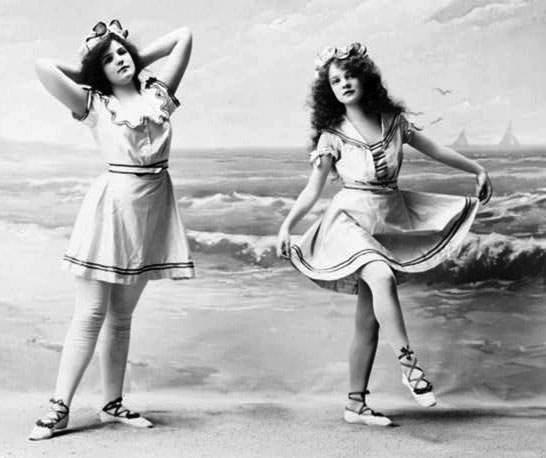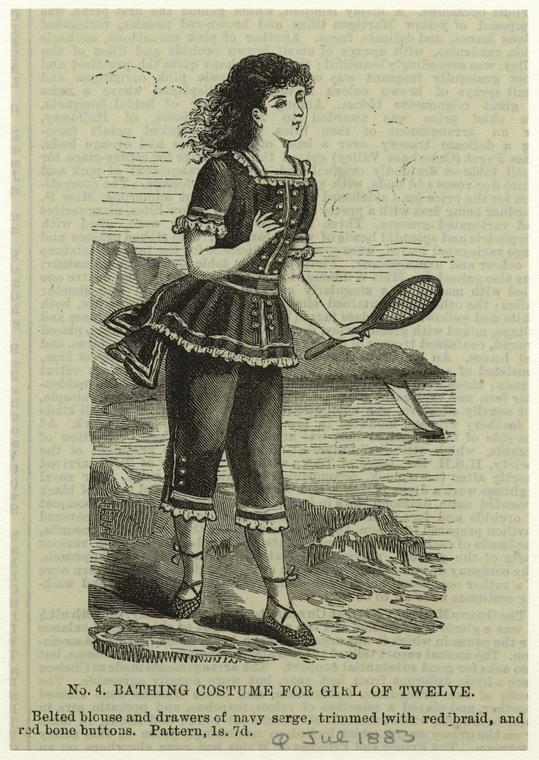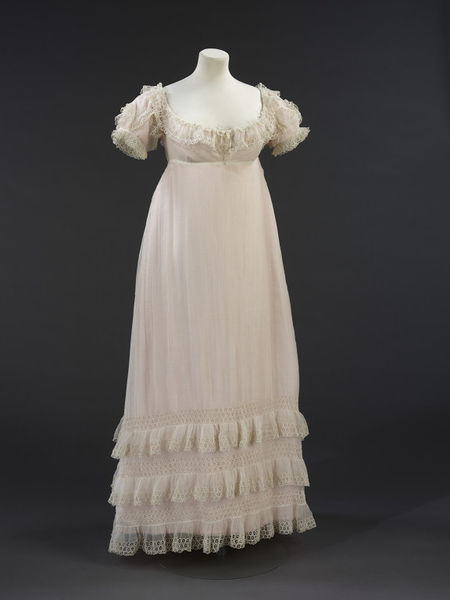By the Beautiful Sea


by Catherine Scholar. Originally published in the May / June, 2009 issue of Finery.
What’s nicer than spending a sunny summer day at the seashore? For centuries, such a thing was never even considered. Going to the beach for fun was unheard of until eighteenth century doctors began prescribing sea-bathing for health problems. Even then, swimming itself was unknown; most bathers took a quick dip into the freezing water and then scrambled for the shore. The sexes were completely segregated. Men typically swam in the nude, while ladies wore long loose muslin gowns, often weighted at the hems to keep them from floating upward. In the mid-nineteenth century, the popularity of sea-bathing soared.
A number of factors contributed to the sport’s increasing popularity: labor laws and mandatory vacation policies gave nearly everyone at least some leisure time, and the development of the railway gave most people easy access to a swimming spot. Suddenly the middle class had time for play and the means to access it.
Once people embraced the concept of going to the beach for fun, the dynamics of the activity changed. Families spent the entire day at the beach, picnicking and playing in the surf. Suddenly men and women were bathing together, which meant that ladies wanted to wear something both more opaque than damp muslin and more attractive than a smock. Men just needed to wear something.
Men’s bathing costumes changed little throughout the nineteenth century. The first swimsuits for men originated in France in the 1830s, where mixed-sex bathing had been permitted since the late 1700s. These early suits were short-legged wool drawers known as “calecons”, which tied at the waist with string. As these suits had a nasty habit of succumbing to gravity, the one-piece costume replaced the drawers in the 1870s. It had short sleeves and short pant legs, and buttoned up the front. Because men’s suits so closely resembled their undergarments, they were usually made in solid black or wide horizontal stripes. This suit held sway until the 1930s, when modern fabrics and relaxing modesty standards allowed men to bare their chests in public.
Ladies bathing costumes were considerably more complex. In the mid-nineteenth century, bathing suits consisted of a dress or blouse, usually hemmed considerably below the knees, worn over voluminous ankle-length trousers. Sleeves were usually long. Accessories included stockings, shoes, hats or scarves, and frequently corsets. The favored material was wool flannel, because it was warm when wet, was considered “healthfully stimulating” (read: scratchy) to the skin, and didn’t cling immodestly when wet. Suits were generally dark colored, and white was actively discouraged because it became transparent when wet. Obviously these suits were more suited to wading, paddling and picnicking than actual swimming; a fully-soaked wool suit could weigh up to 20 pounds. And while women were enjoying themselves at the seaside, very few of them actually swam, which was still considered a masculine activity.
As the century progressed, skirts, sleeves and trousers all shortened. By 1870, the trousers ended below the knee. They had narrowed considerably and generally had straight legs, although some were gathered in at the bottom. The dresses came to about the knee, hemmed shorter than the trousers, and sleeves were short. Stockings were wool or silk, and shoes were usually pumps, laced around the ankle like espadrilles. A straw hat, ruffled cap or simple bandana covered the head and controlled the hair. Most bathing suits were simply constructed, in black or navy with simple white or red trim. Wool flannel was still the most common material, but serge, alpaca and twilled cotton were also used. Magazines depicted “fashionable” suits that followed the lines of stylish gowns, but few if any have survived, if indeed any woman actually opted to swim in a swagged overskirt, vested tight bodice with peplum, or a mock-shepherdess getup.
In the 1890s, women began embracing sports and outdoor activities. The fashion magazines were full of specialized outfits for riding, mountaineering, yachting, etc., and swimsuits took great leaps toward functionality in this decade. The trousers were sometimes replaced by a one-piece romper garment, fastening on the shoulders and with short legs elasticized above the knees. The romper was covered by a dress or skirt that fastened around the waist. The rompers provided greater mobility and modesty while actually swimming. Suits remained in this form through the Edwardian period, when Australian “underwater ballerina” Annette Kellerman left off her overdress when performing in the United States in 1907, choosing to wear a more functional loose-fitting version of the romper. She was promptly arrested for indecent exposure, but her suit was widely adopted and gradually tightened and shortened until it became the one-piece maillot modern women love or loathe.




Leave a comment